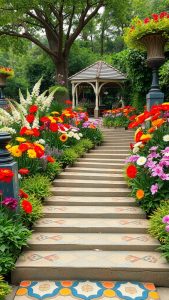Whether you’re a seasoned gardener or just starting out, creating an herb garden can be a fun and rewarding project. With 31 herb garden ideas at your fingertips, you’ll find inspiration that suits your space, from balcony boxes to backyard beds. Let’s dig into some creative ways to grow your favorite herbs and add a splash of greenery to your life!
Herb Garden in a Barrel

Creating an herb garden in a barrel is a fun and creative way to elevate your gardening game. This image showcases a beautifully arranged barrel overflowing with vibrant herbs and flowers. The rustic look of the barrel adds charm and can fit into any outdoor space.
To set up your own herb garden in a barrel, start by selecting a container. A wooden barrel like the one shown works perfectly because it provides good drainage and adds a decorative touch. Fill it with a mix of potting soil and compost to give your herbs the best start.
Consider planting a variety of herbs that you love to cook with. Basil, parsley, and mint are great options. Adding a few colorful flowers, like marigolds or nasturtiums, can also attract beneficial insects and enhance the visual appeal of your barrel garden.
Water the herbs regularly, ensuring they get enough sunlight. You’ll enjoy the fresh aromas and flavors right from your backyard. Plus, a barrel herb garden is an easy conversation starter for visitors!
Herb Garden in a Teacup

Creating an herb garden in a teacup is a charming idea that adds a touch of whimsy to any space. This concept combines functionality with creativity, allowing you to grow fresh herbs right on your kitchen table.
The image showcases a delicate teacup adorned with a beautiful gold rim, filled with vibrant green herbs. It’s an inviting sight that inspires you to try your hand at indoor gardening. Using a teacup not only saves space but also makes for a unique decorative piece.
To get started, choose small herbs like thyme or basil that thrive in limited space. Ensure your teacup has drainage holes or add small stones at the bottom for proper water flow. Fill it with potting soil and place your chosen herb seeds or seedlings inside. Water them gently and place the teacup in a sunny spot.
This simple project is perfect for beginners and can be a fun activity to do with friends or kids. It’s a lovely way to enjoy fresh herbs for cooking while also brightening up your home!
Vertical Herb Garden Towers

If you’re looking to maximize your space while growing your favorite herbs, vertical herb garden towers are a clever solution. These structures allow you to stack plants vertically, making them ideal for small patios or balconies.
In the image, you can see a vibrant display of herbs arranged in a tall, green tower. Each tier showcases a variety of lush greens, demonstrating how different plants can coexist beautifully in a compact area. This arrangement not only saves space but also adds a lively touch to your garden.
One of the best things about vertical herb garden towers is their versatility. You can grow culinary herbs like basil, mint, and thyme, which are great for enhancing your cooking. Plus, they are easy to maintain and can thrive with the right care and sunlight.
Setting up one of these towers is straightforward. Start by selecting a sturdy tower that allows for good drainage. Choose your favorite herbs and plant them in each tier. Make sure to keep the soil moist and provide adequate sunlight, and you’ll have a thriving herb garden in no time!
Indoor Herb Garden Kits
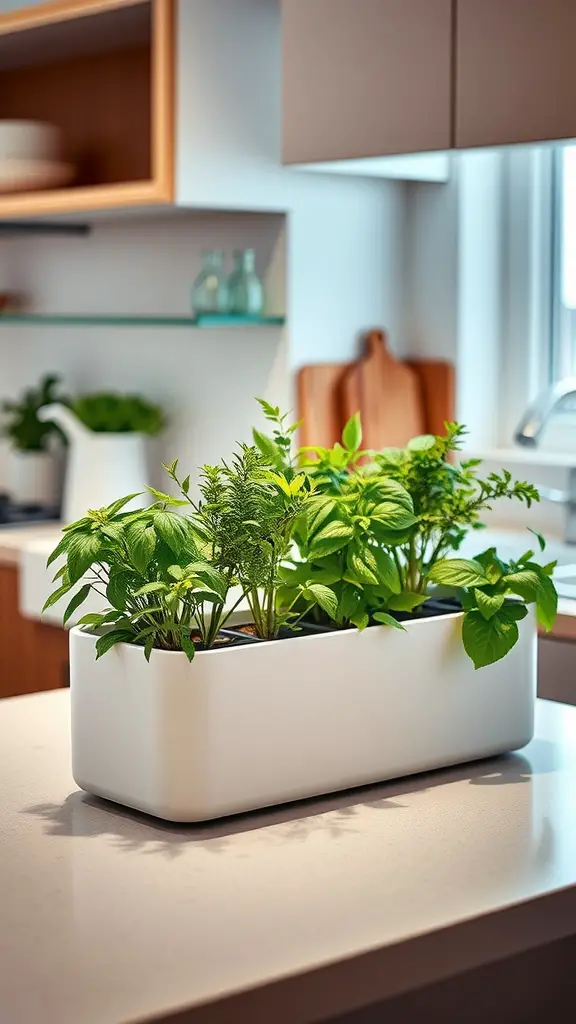
Indoor herb garden kits are a fantastic way to bring greenery into your home. They allow you to grow fresh herbs right in your kitchen or living space.
The image shows a sleek, modern planter filled with vibrant herbs. These include leafy greens and aromatic plants, perfect for cooking and garnishing.
Having an indoor herb garden means you can easily access fresh ingredients for your meals. Imagine snipping a few basil leaves or sprigs of parsley right before adding them to your dish!
Most kits come with everything you need—pots, seeds, and sometimes even soil. They are designed to fit neatly on countertops, making them practical and visually appealing.
Whether you’re a seasoned chef or just starting, growing herbs indoors can enhance your cooking experience and add a refreshing touch to your home decor.
Raised Bed Herb Gardens

Raised bed herb gardens are a fantastic way to grow fresh herbs right at home. The image shows a neatly organized garden space, showcasing a variety of herbs thriving in a wooden raised bed. The wooden structure not only defines the garden area but also ensures that the plants have good drainage and are easy to access.
In the picture, you can see different herbs like mint and some leafy greens growing lushly. They are arranged in a way that maximizes space and sunlight, allowing each plant to flourish. This setup is perfect for beginners and seasoned gardeners alike, as it simplifies maintenance while producing fresh ingredients for your kitchen.
Raised beds also have the added benefit of being easy to maintain. They can help keep weeds at bay and create a more controlled environment for your herbs. Plus, they look great in any yard or garden space!
Herb Spiral Garden Design

A herb spiral garden is a delightful and efficient way to grow a variety of herbs in a small space. The design features a spiral shape that allows for different microclimates, making it ideal for planting a mix of herbs that have varying light and water requirements.
In the image, you can see a beautifully arranged herb spiral garden. The wooden structure adds a rustic touch and helps to define each section of the spiral. The different levels of the spiral create areas that receive varying amounts of sunlight, which is perfect for growing herbs like basil, mint, and thyme.
The vibrant green leaves of the plants stand out against the rich brown soil, showcasing the diversity of herbs thriving together. Not only does it look attractive, but it also promotes healthy growth. Nearby, a small pot hints at additional plants that can be added to complement the spiral garden.
This design is particularly friendly for small gardens or patios, making it accessible for anyone interested in gardening. Herb spirals also make it easier to harvest your herbs, as everything is within reach. Plus, they can be a fun project to create with family or friends.
Hanging Herb Planters
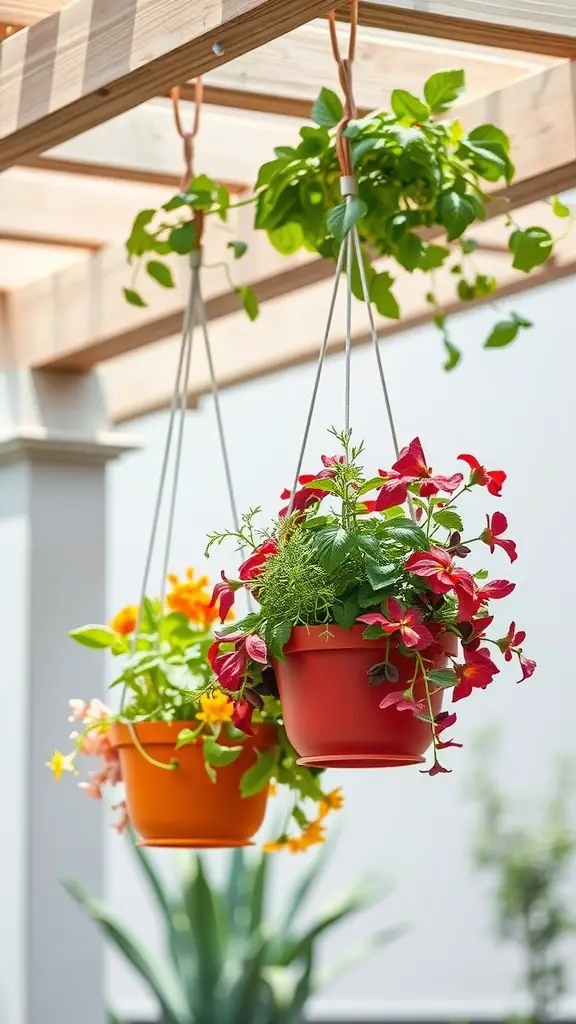
Hanging herb planters are a delightful way to bring greenery into your space. They not only add visual interest but also offer easy access to fresh herbs right in your kitchen or garden.
In the image, you can see vibrant pots suspended from a wooden structure. The pots are filled with various herbs and flowers, adding a lovely pop of color. Each planter is designed to allow ample sunlight and airflow, which is essential for healthy growth.
Using hanging planters is perfect for those with limited space. You can easily place them on a balcony, patio, or even inside your home. Just think of the convenience of having basil, cilantro, or mint at arm’s reach while cooking!
To create your own hanging herb garden, start by selecting your favorite herbs. Some easy options include parsley, chives, or thyme. Make sure your pots have drainage holes and choose a lightweight potting mix. Hang them in a spot that gets plenty of sunshine, and water them regularly to keep them thriving.
Hanging planters can also serve as a decorative element. You can mix different colors and styles of pots to match your aesthetic. This not only brightens up your home but also encourages you to use your herbs more often.
Window Box Herb Gardens

Creating a window box herb garden is a delightful way to bring fresh flavors into your kitchen. These small garden spaces tucked right by your window can be both practical and charming.
In the image, you can see a neatly arranged window box filled with vibrant herbs. The lush greenery includes plants that are perfect for cooking and garnishing. Imagine stepping into your kitchen and having fresh mint or chives just a reach away!
Window boxes are not only space savers but also add a touch of nature to your home. They can fit on any ledge or balcony, providing a little green oasis. With the right herbs, you can elevate your meals, making everything from salads to sauces taste brighter and more flavorful.
To set up your own window box, choose herbs that you frequently use. Some great options include basil, parsley, and thyme. Make sure to use good potting soil and ensure your box gets plenty of sunlight. Water your herbs regularly, and soon you’ll have a thriving garden right outside your window!
Herb Wall Art

Creating a unique herb wall art piece is a fun way to combine nature and design in your home. The image showcases a beautiful wooden frame that serves as both a decorative element and a functional space for herbs.
Inside the frame, vibrant green herbs peek out, giving the impression of a living painting. This clever design not only adds a splash of color to your wall but also makes it easy to grow and access fresh herbs for cooking.
Hanging herbs like parsley, mint, and thyme add to the visual appeal. This setup is perfect for kitchens or dining areas where you can easily snip fresh herbs while you cook. Plus, it inspires creativity, encouraging you to think about how you can integrate more greenery into your home decor.
To make your own herb wall art, select a frame you love and choose herbs that thrive indoors. Consider using small pots that fit within the frame or a wire mesh to hold the herbs. With a little imagination, you can create a piece that not only beautifies your space but also delights your senses!
Cinder Block Herb Garden

A cinder block herb garden is a clever way to combine functionality and style. Using cinder blocks not only provides a sturdy structure but also offers a unique look for your outdoor space. In the image, you can see how the blocks create distinct planting areas, making it easy to organize various herbs.
This type of garden is perfect for those who want to grow their own herbs without needing a large space. The blocks can be stacked to create different heights, which adds visual interest. Plus, they are a budget-friendly option for gardeners of all skill levels.
In the photo, a lush array of herbs is thriving. You might spot mint, basil, and possibly some flowering herbs. These plants not only add flavor to your meals but also bring pleasant aromas to your garden.
To set up your own cinder block herb garden, start by gathering cinder blocks and arranging them in a layout that suits your space. Fill the cavities with potting soil, and choose your favorite herbs to plant. Water them regularly and enjoy the fresh flavors right from your backyard!
Herb Garden with Edible Flowers

Creating a herb garden with edible flowers is a delightful way to add beauty and flavor to your cooking. Imagine vibrant colors and fresh scents all in one space. This image showcases a lively mix of herbs and flowers, making it visually appealing and useful in the kitchen.
In the garden, you can see an array of flowers like red, yellow, and purple, alongside herbs that are perfect for culinary use. Plants like calendula and nasturtium not only brighten up the garden but are also edible, adding unique flavors to salads and dishes. Plus, they attract beneficial insects, promoting a healthier garden.
To create your own herb garden with edible flowers, start with containers or a dedicated garden bed. Choose herbs such as basil, thyme, or mint, and mix in some colorful edible flowers. Water them regularly and provide plenty of sunlight. Harvest the herbs and flowers as needed to enjoy fresh flavors in your meals.
Incorporating edible flowers into your cooking is easy. For a simple salad, toss mixed greens, sliced cucumbers, and some edible blooms for a pop of color. Drizzle with your favorite dressing and enjoy a dish that’s as tasty as it is beautiful!
Herb Garden in Old Boot

An old boot is a surprising yet charming way to create a unique herb garden. In this image, you can see a rugged boot, its worn leather hinting at past adventures, now repurposed to house thriving green herbs. This creative idea adds a touch of personality to any garden space.
Using a boot for planting not only recycles an item that might otherwise be discarded but also provides a quirky focal point. The herbs seem to emerge confidently from the boot’s opening, inviting curiosity and smiles from anyone who passes by. You can plant mint, thyme, or any small herb that can thrive with limited soil depth.
To set up your own boot herb garden, start by cleaning the boot and ensuring it has drainage holes. Fill it with potting soil and add your chosen herbs. Water them regularly, and soon you’ll have a delightful display that blends nature with creativity.
Kitchen Countertop Herb Garden
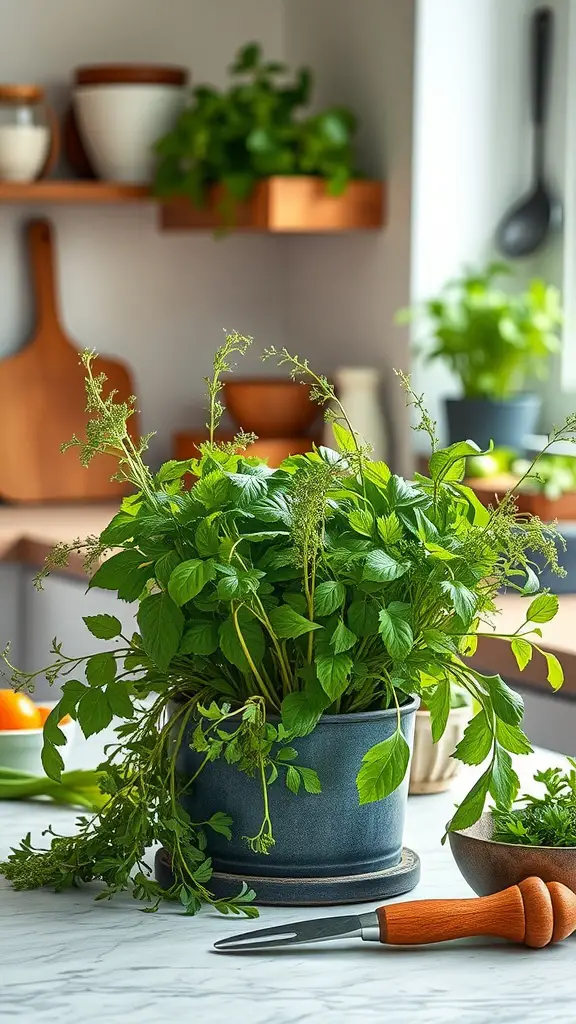
Creating a kitchen countertop herb garden is a delightful way to bring fresh flavors to your cooking. Imagine stepping into your kitchen and having a pot of fresh herbs right at your fingertips. This image showcases a lush herb plant, which could be mint or parsley, thriving in a stylish pot.
Using herbs like these in your meals can enhance not only the taste but also the aroma of your dishes. You can snip off a few leaves while preparing dinner, adding a burst of freshness to your recipes. The vibrant green leaves in the pot contrast beautifully with the kitchen’s warm decor, making it a perfect focal point.
To start your own countertop herb garden, choose a sunny spot in your kitchen. A window ledge is often ideal, as herbs love natural light. Consider planting a variety of herbs such as basil, cilantro, or rosemary. Each offers unique flavors and can be used in a variety of dishes.
Taking care of your herb garden is simple. Water the plants when the soil feels dry and ensure they have good drainage. With a bit of love and attention, you’ll soon be enjoying the benefits of your homegrown herbs.
Aquaponic Herb Garden
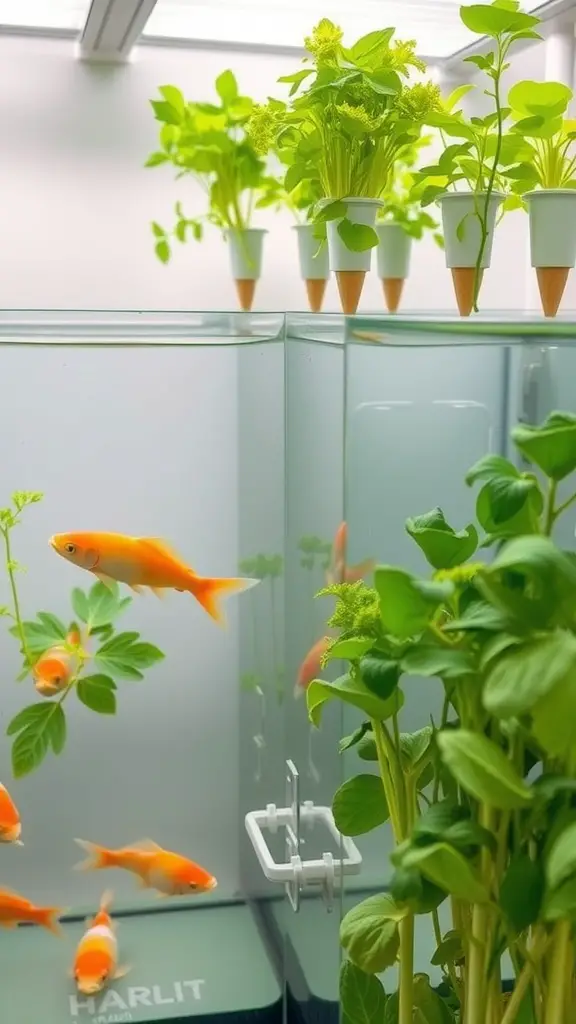
An aquaponic herb garden is a unique and fun way to grow fresh herbs while also caring for fish. In the image, you can see a clear tank containing vibrant orange fish swimming happily. Above the water, there are small herb plants in white containers, looking lush and green.
The concept combines aquaculture and hydroponics. Fish waste provides organic nutrients for the plants, and in return, the plants help filter the water for the fish. This cycle creates a balanced ecosystem. You can grow herbs like basil, mint, and cilantro, all of which thrive in this setup.
Setting up an aquaponic herb garden is simpler than you might think. Start with a tank for your fish and a grow bed for your herbs. Ensure the fish are healthy and the plants have enough light. Regular maintenance, like feeding the fish and checking water quality, will keep everything thriving.
Not only does this method save space, but it also adds a touch of nature to your home. Imagine snipping off fresh herbs for your meals while watching the fish swim around. It’s a delightful experience!
Herb Garden with Rock Path

Creating an herb garden can be a delightful project, especially when you add a charming rock path. This image shows a beautifully designed path winding through a lush garden filled with various herbs and vibrant flowers.
The stone pathway not only provides a practical route through the garden but also adds a rustic touch. As you stroll along the path, you can easily access your favorite herbs like basil, parsley, or thyme, making this layout both functional and inviting.
Consider using flat stones that are easy to walk on, and leave some gaps for grass or small plants to peek through. This gives a natural feel to the garden while allowing for easy maintenance. Surrounding the path with a mix of greenery and colorful blooms enhances the beauty of your herb garden. You can enjoy the aroma and flavors of fresh herbs while taking a peaceful walk through your outdoor space.
Community Herb Garden

A community herb garden is a delightful way to bring people together. In this image, we see three individuals actively tending to a vibrant herb garden. The greenery is lush, with various plants thriving in neat rows. This scene highlights the joy of gardening as a group activity.
The child in the foreground is engaged in planting or caring for the herbs, showcasing how gardening can be a fun learning experience for kids. Meanwhile, the adults are involved in their own tasks, demonstrating teamwork and collaboration. Community gardens offer a space where everyone can contribute and enjoy the fruits of their labor.
Creating a community herb garden can also encourage healthy eating habits. Fresh herbs can be used in countless recipes, adding flavor and nutrition. Imagine picking some fresh basil or cilantro right from your garden to enhance your meals!
Herb Garden with Natural Fencing
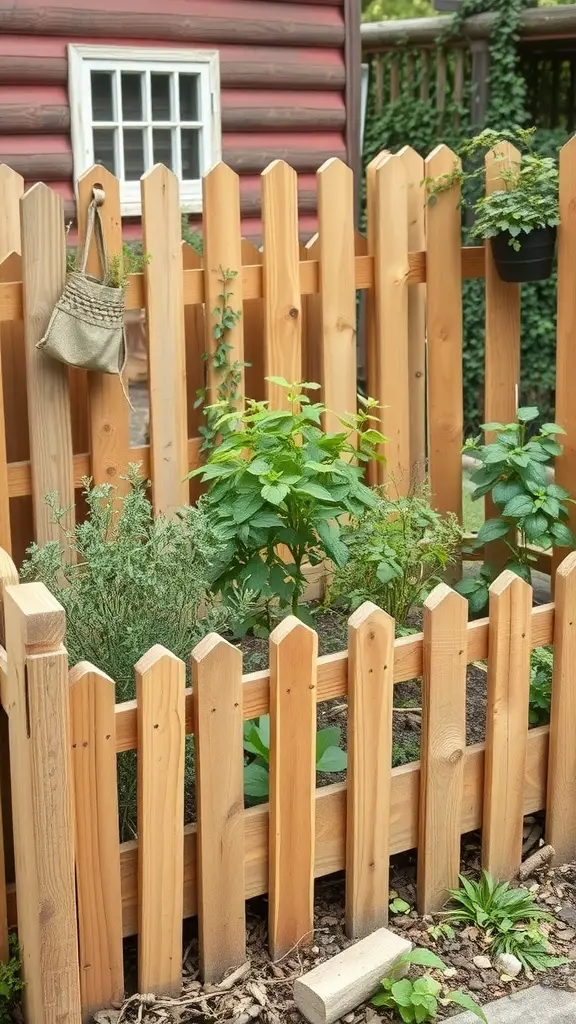
Creating a herb garden with natural fencing is a delightful way to combine functionality and aesthetics. In the image, we see a charming garden surrounded by a wooden fence that not only keeps plants safe but also adds a rustic touch to the space.
The wooden fencing is simple yet effective, allowing for easy access while keeping pets and children at bay. This setup encourages a cozy atmosphere, making it a perfect spot for gardening enthusiasts to nurture their herbs.
Inside the garden, various herbs are thriving. The vibrant greens of the plants suggest they are well cared for. Popular choices like basil, mint, and rosemary can easily flourish in such an environment. Using natural materials for fencing is an eco-friendly choice, blending seamlessly with the surrounding nature.
Additionally, the small hanging bag on the fence adds a nice touch, perfect for storing gardening tools or fresh-cut herbs. If you’re considering starting your own herb garden, think about how fencing can shape the layout and aesthetic of your space. A well-defined area not only looks appealing but also makes it easier to manage your plants.
Hedge Herb Garden

A hedge herb garden offers both beauty and functionality. The image showcases a well-defined space surrounded by neatly trimmed hedges. This creates a cozy, inviting atmosphere. The bright green of the hedge contrasts beautifully with the lush herbs growing inside.
In the center, a patch of healthy herbs is visible, suggesting a variety of flavors waiting to be harvested. Herbs like basil, parsley, and mint thrive in such gardens, making them perfect for culinary adventures. You can easily snip fresh herbs for your favorite dishes, enhancing flavors naturally.
Planning this type of garden can be a fun project. Start by choosing your favorite herbs and ensuring they get enough sunlight. Use the hedges not only for aesthetics but also to protect your herbs from harsh winds. This setup creates a serene escape where you can relax and enjoy your gardening efforts.
Herb Garden with Terracotta Pots
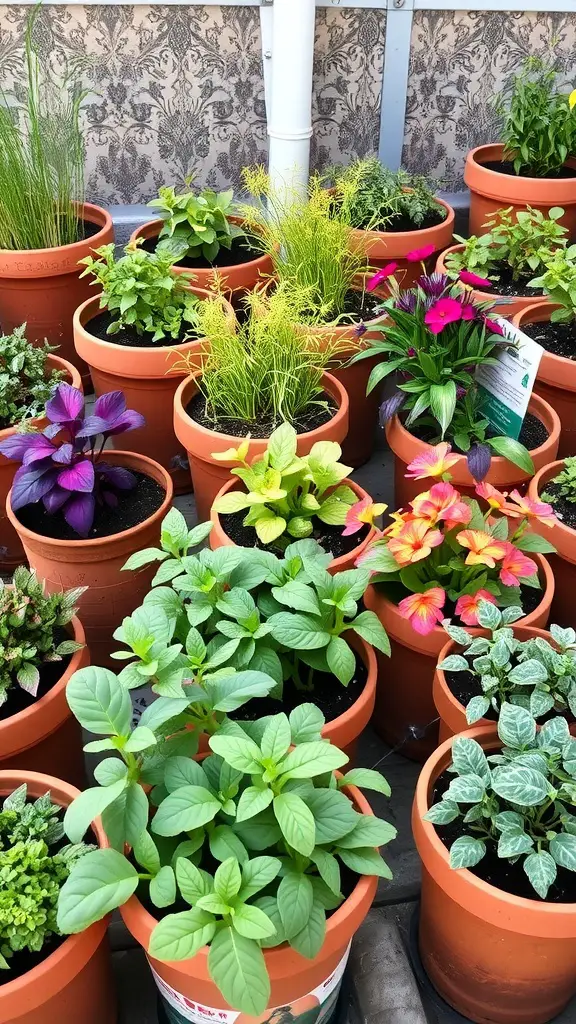
Creating an herb garden with terracotta pots is a fun and rewarding project. These pots not only look charming but also provide good drainage for your herbs. In the image, you can see a delightful arrangement of various herbs, each thriving in its own pot.
Terracotta is a classic choice for gardening. It allows plants to breathe and helps regulate moisture levels. You might notice different herbs like basil, mint, and oregano, which are perfect for cooking and can add fresh flavors to your meals.
One of the joys of having an herb garden is being able to step outside and snip some fresh herbs for your dishes. Think about using these herbs in a simple pasta recipe. Just sauté garlic in olive oil, add your favorite vegetables, and toss in chopped fresh herbs for a burst of flavor!
Terracotta pots also make it easy to rearrange your garden as needed. You can move them around to catch the sunlight or to create a more visually appealing display. Plus, they come in various sizes, making it easy to find the right pot for each herb.
Herb Garden in a Greenhouse
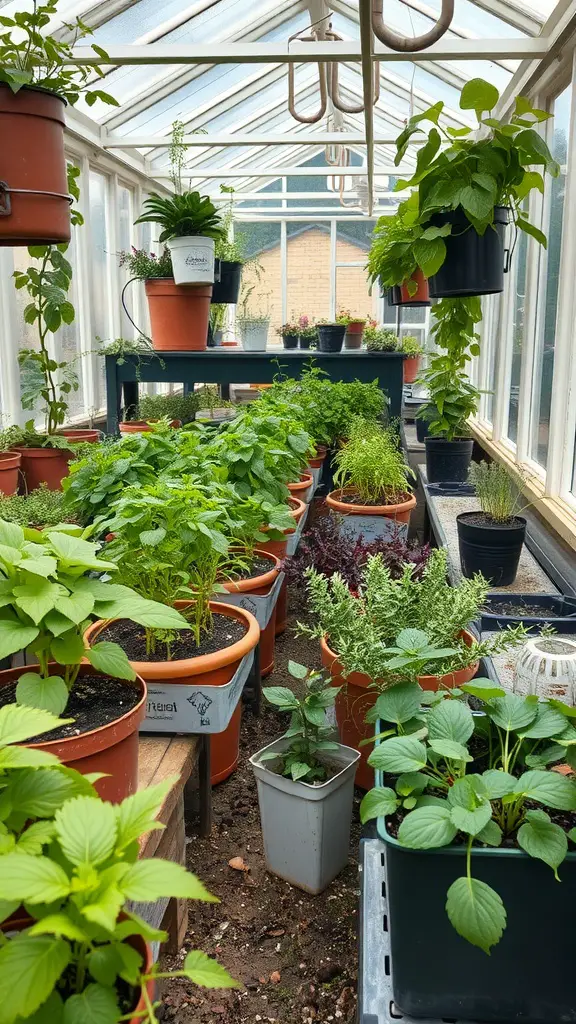
Imagine stepping into a cozy greenhouse filled with fresh herbs ready to be picked. This herb garden showcases a variety of potted plants, each thriving in its own space. The vibrant green leaves are a welcoming sight, and the earthy scent of herbs fills the air.
The layout is both practical and appealing. You can see plants like mint, basil, and thyme, neatly arranged in terracotta pots. These pots not only look great but also provide good drainage, ensuring healthy growth. Some plants are even grown in hanging pots, utilizing vertical space and adding visual interest.
This greenhouse environment is ideal for herbs as it protects them from harsh weather while allowing plenty of sunlight to stream in. Whether you want to cook with fresh ingredients or create soothing teas, having a dedicated space for herbs can be extremely rewarding.
Starting your own herb garden in a greenhouse is straightforward. All you need are some pots, quality soil, and seedlings or seeds of your favorite herbs. Regular watering and occasional pruning will keep them healthy and productive.
With a little care, you can enjoy the benefits of fresh herbs right at your fingertips. Explore different varieties and find your favorites to spice up your meals!
DIY Herb Mortar and Pestle Setup

If you’re diving into the world of herb gardening, creating your own mortar and pestle setup can enhance your experience. The image depicts a charming mortar and pestle nestled among vibrant herbs, making it easy to imagine using fresh ingredients right from your garden.
The mortar is a lovely earthy color, with a delicate ribbon tied around it, adding a touch of personality. It sits in a bed of lush green herbs like mint, oregano, and possibly some edible flowers. This setup is perfect for those who love to incorporate fresh flavors into their dishes.
To create a similar setup at home, start by choosing a location in your garden or kitchen where you can keep your herbs. Select plants that you enjoy using in your cooking. Once your herbs are thriving, gather your mortar and pestle, and get ready to enjoy the full flavor of fresh herbs!
Herb Garden on a Balcony
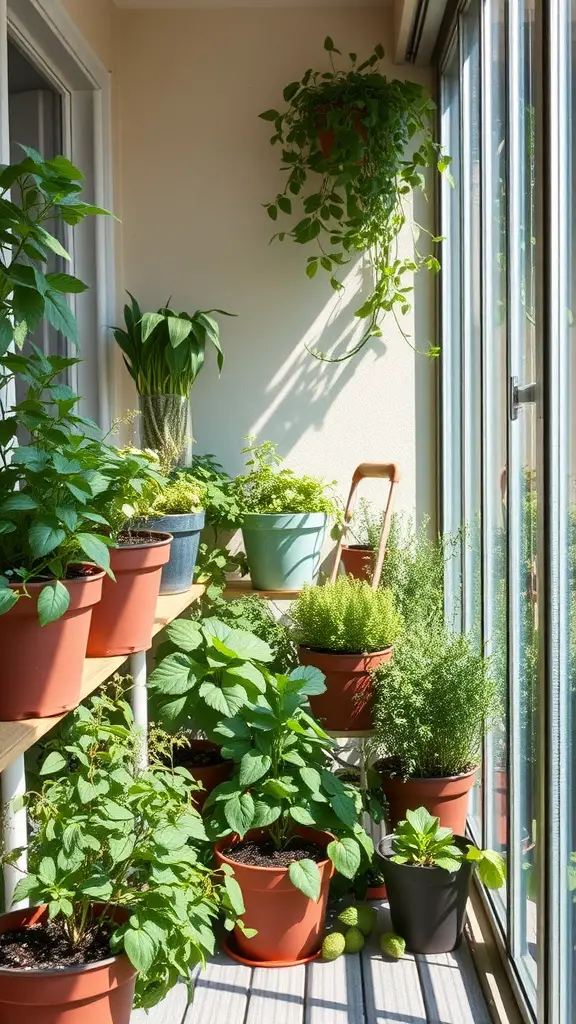
Transforming your balcony into a cozy herb garden is a fun and rewarding project. The image showcases a vibrant collection of potted herbs, bringing life to a small space.
The balcony features various pots in different sizes, filled with lush greenery. You can see plants like basil, mint, and thyme, which are easy to grow and perfect for cooking. Incorporating these herbs adds flavor to your meals while also enhancing the aesthetic of your outdoor area.
Using vertical space is key in a compact balcony garden. The image shows some pots arranged on shelves, making good use of height. This design not only saves space but also provides the herbs with adequate sunlight.
Don’t forget to consider drainage when choosing pots. You want to ensure that excess water can escape, preventing root rot. Adding stones at the bottom of your pots can help with this.
To maintain your herb garden, regular watering and occasional pruning are important. Harvesting leaves encourages new growth, so feel free to snip off some fresh herbs for your next meal. With a little care, your balcony herb garden will flourish and provide you with fresh ingredients throughout the season.
Herb Garden with Bird Feeder

Imagine stepping into your own little paradise filled with vibrant herbs and cheerful birds. An herb garden with a bird feeder creates a delightful atmosphere. The combination attracts colorful birds while giving you fresh herbs for your cooking.
In the image, you can see a charming bird feeder surrounded by lush greenery and blooming flowers. The feeder stands tall, beckoning birds to visit. This setup not only provides food for the birds but also adds height and interest to your garden.
Growing herbs like basil, rosemary, and mint near your bird feeder is a great idea. These herbs are easy to grow and can be used in countless dishes. Plus, the aromatic scents can attract even more birds, making your garden a lively spot.
To create your own herb garden with a bird feeder, select a sunny spot. Plant your favorite herbs in rich soil, ensuring they have enough space to grow. Place the feeder nearby, filled with seeds, and watch as birds flock to your garden.
Herb Garden with a Water Feature

Imagine stepping into a cozy herb garden where a soothing water feature takes center stage. This scene is all about combining the beauty of greenery with the calming sounds of water. The gentle flow from the fountain brings a sense of tranquility, making it the perfect spot to unwind.
The plants surrounding the fountain are a delightful mix of vibrant colors and textures. You’ll find lush foliage climbing the wooden fence, and hanging pots bursting with herbs. These plants not only add visual appeal but also provide fresh ingredients for cooking. Think basil, thyme, and mint—each one ready to enhance your favorite dishes.
The fountain adds a lovely focus to the garden. It creates a peaceful atmosphere, encouraging you to take a moment to breathe and enjoy nature. The sound of trickling water can be so refreshing, especially on warm days.
Incorporating a water feature in your herb garden can transform it into a haven. It’s about more than just aesthetics; it’s about creating a space where you feel relaxed and connected to nature. Whether you’re tending your herbs or simply enjoying a cup of tea by the fountain, this garden invites you to slow down and savor the moment.
Herb Garden with Mulching

Mulching is a simple yet effective way to enhance your herb garden. In the image, you can see vibrant green herbs growing amidst a layer of mulch. This setup not only adds to the visual appeal but also provides several benefits for your plants.
One of the main advantages of mulching is that it helps retain moisture in the soil. This is especially crucial for herbs, which thrive in well-drained but consistently moist conditions. The mulch acts as a barrier, reducing evaporation and ensuring that your plants get the hydration they need.
Additionally, the mulch suppresses weeds, meaning your herbs won’t have to compete for nutrients. This allows them to grow more robust and healthy. It’s also beneficial for regulating soil temperature, keeping it cooler during hot days and warmer during cooler nights.
When setting up your herb garden, consider using organic mulch materials like wood chips or straw. These not only look nice but also break down over time, enriching the soil as they decompose. So, if you’re planning to start or improve your herb garden, mulching is definitely a technique you should consider!
Herb Bed with Seasonal Plants

Creating an herb bed with seasonal plants can bring both beauty and functionality to your garden. Imagine a lush arrangement where herbs mingle with colorful blooms. This combination not only looks pleasing but also attracts beneficial insects.
In the image, you can see vibrant flowers like yellow daisies and pink blooms surrounded by leafy herbs. The contrast of colors makes the garden pop and adds a cheerful atmosphere. These seasonal plants can thrive together, providing a feast for the eyes and flavors for the kitchen.
Consider including herbs like mint and basil, which pair well with many dishes. You can even grow small vegetables, like the yellow ones seen in the image. This way, you have fresh ingredients right at your fingertips!
To design your own herb bed, start by selecting a sunny spot in your garden. Prepare the soil by adding compost for nutrients. Then, arrange your chosen herbs and seasonal plants, keeping in mind their growth habits. Regular watering and some love will ensure your garden flourishes.
Herb Garden for Pollinators

Creating an herb garden that attracts pollinators is a delightful way to enhance your backyard. In the image, colorful flowers bloom alongside herbs, and a butterfly gracefully flits about, adding life to the scene. These vibrant plants not only beautify your space but also play a crucial role in supporting our ecosystem.
To design a pollinator-friendly herb garden, consider incorporating herbs like basil, mint, and rosemary. These herbs not only serve culinary purposes but also attract bees and butterflies. You can plant them among brightly colored flowers, like zinnias and cosmos, which are known to be irresistible to these helpful insects.
It’s important to select native plants for your garden, as they are more suited to local pollinators. Additionally, try to avoid pesticides, as they can harm beneficial insects. Regularly watering your plants and allowing some of them to flower will create a welcoming space for pollinators.
In summary, a herb garden designed for pollinators can be both functional and beautiful. By choosing the right plants and caring for them properly, you can enjoy a thriving garden full of life and color.
Herb Garden in an Old Wheelbarrow

Transforming an old wheelbarrow into a herb garden is a delightful way to add a touch of charm to your outdoor space. This idea not only repurposes an item that might otherwise go to waste but also creates a unique focal point in your garden.
The image beautifully captures a rustic wheelbarrow filled with vibrant green herbs. The wheelbarrow’s weathered look adds character, blending perfectly with the surrounding greenery and flowers. It invites you to imagine stepping into a cozy garden filled with fresh aromas.
To create your own herb garden in a wheelbarrow, start by choosing the right spot in your yard. Ensure it gets plenty of sunlight and is easily accessible for watering and harvesting. Next, fill the wheelbarrow with quality potting soil, leaving enough space for your herbs.
Consider planting a mix of your favorite herbs—basil, parsley, and mint are popular choices. You can also add some flowering herbs like chives, which bring beauty and a splash of color. Water regularly and make sure to check for pests. Soon, you’ll have a lovely herb garden that’s easy to maintain and a joy to use in your cooking.
Herb Garden with Decorative Stones

Creating a herb garden is a rewarding project that brings both beauty and functionality to your outdoor space. In this design, decorative stones play a key role in enhancing the overall look of the garden while also providing practical benefits.
The arrangement of the herbs, like the vibrant green leaves of the plants, contrasts beautifully with the smooth stones scattered throughout the garden. These stones serve as natural pathways, making it easier to navigate without trampling on the herbs. Plus, they add a touch of elegance to the design.
Using stones can also help with drainage and weed control. When arranged thoughtfully, they create visual interest, breaking up the soil and greenery. It’s a simple way to elevate your herb garden while keeping it functional.
To start your own herb garden with decorative stones, choose a variety of herbs you enjoy cooking with, such as basil, parsley, and mint. Plan out the layout and incorporate different sizes of stones for depth. As you plant, arrange the stones to guide the eye through your garden and create inviting pathways.
This combination of herbs and stones not only enhances your cooking but also adds a serene element to your backyard. Whether you have a large garden or a small balcony, this idea is adaptable and easy to implement.
Herb Garden with Fairy Lights

Picture your herb garden twinkling under the night sky. Adding fairy lights brings a touch of magic that transforms your gardening space into an enchanting retreat. These charming lights create a warm glow that highlights the lush greenery and vibrant herbs.
In this setup, you can see herbs like thyme and rosemary, standing tall and proud amidst the soft illumination. The lights not only enhance the aesthetics but also make your garden inviting for evening gatherings or peaceful moments alone.
Consider placing the lights around your herb pots or along trellises to create a cozy atmosphere. This small addition can turn your garden into a delightful spot for evening dining or relaxation. A herb garden isn’t just about the plants; it’s also about creating a space that feels welcoming and soothing.
Pallet Herb Gardens
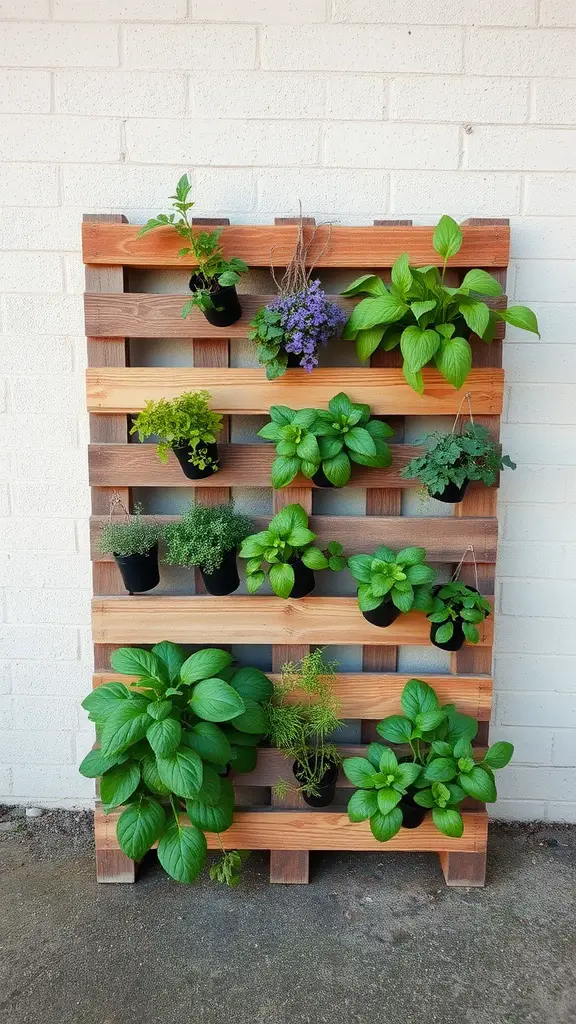
Pallet herb gardens are a fantastic solution for those with limited space. Using a wooden pallet, you can create a vertical garden that not only saves space but adds a rustic charm to your outdoor or indoor area. The beauty of this design is its simplicity and accessibility.
The image showcases a well-arranged pallet herb garden. Each row features small pots filled with various herbs, showcasing vibrant greens and hints of purple. Plants like mint, basil, and thyme thrive in this setup, making it perfect for culinary enthusiasts.
Creating your own pallet herb garden is easy. Start by securing a wooden pallet against a wall. Then, choose your favorite herbs and place them in pots that can hang from or fit into the pallet. Remember to ensure proper drainage so your herbs can flourish.
This vertical garden not only looks lovely but also allows you to harvest fresh herbs right from home. It’s a delightful way to enhance your cooking and enjoy the satisfaction of growing your own plants.

